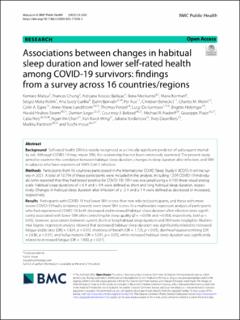| dc.description.abstract | Background
Self-rated health (SRH) is widely recognized as a clinically significant predictor of subsequent mortality risk. Although COVID-19 may impair SRH, this relationship has not been extensively examined. The present study aimed to examine the correlation between habitual sleep duration, changes in sleep duration after infection, and SRH in subjects who have experienced SARS-CoV-2 infection.
Methods
Participants from 16 countries participated in the International COVID Sleep Study-II (ICOSS-II) online survey in 2021. A total of 10,794 of these participants were included in the analysis, including 1,509 COVID-19 individuals (who reported that they had tested positive for COVID-19). SRH was evaluated using a 0-100 linear visual analog scale. Habitual sleep durations of < 6 h and > 9 h were defined as short and long habitual sleep duration, respectively. Changes in habitual sleep duration after infection of ≤ -2 h and ≥ 1 h were defined as decreased or increased, respectively.
Results
Participants with COVID-19 had lower SRH scores than non-infected participants, and those with more severe COVID-19 had a tendency towards even lower SRH scores. In a multivariate regression analysis of participants who had experienced COVID-19, both decreased and increased habitual sleep duration after infection were significantly associated with lower SRH after controlling for sleep quality (β = −0.056 and −0.058, respectively, both p < 0.05); however, associations between current short or long habitual sleep duration and SRH were negligible. Multinomial logistic regression analysis showed that decreased habitual sleep duration was significantly related to increased fatigue (odds ratio [OR] = 1.824, p < 0.01), shortness of breath (OR = 1.725, p < 0.05), diarrhea/nausea/vomiting (OR = 2.636, p < 0.01), and hallucinations (OR = 5.091, p < 0.05), while increased habitual sleep duration was significantly related to increased fatigue (OR = 1.900, p < 0.01).
Conclusions
Changes in habitual sleep duration following SARS-CoV-2 infection were associated with lower SRH. Decreased or increased habitual sleep duration might have a bidirectional relation with post-COVID-19 symptoms. Further research is needed to better understand the mechanisms underlying these relationships for in order to improve SRH in individuals with COVID-19. | en_US |

